How DeepSeek Revived Interest in the Jevons Paradox

Understanding Jevons Paradox in Today’s Digital World
What is Jevons Paradox?
Jevons Paradox is an economic theory introduced by British economist William Stanley Jevons in 1865. It suggests that as technology improves energy efficiency, the overall consumption of that energy resource may actually increase, rather than decrease. Initially applied to coal consumption, this principle now extends to various resources, including oil, natural gas, and even digital technology like chips and data storage.
Recent Renewed Interest in Jevons Paradox
In recent weeks, Jevons Paradox has gained traction again, particularly due to rising discussions around technology and artificial intelligence (AI). Following the announcement of DeepSeek, a new AI model that significantly impacts chip and energy demand, terms related to Jevons Paradox spiked on social media and search engines. This renewed focus indicates how technological advances are changing our consumption patterns and expectations regarding energy use.
The Impact of Technology on Consumption
Back in 2003, a typical household might only have one or two digital devices. Fast forward to today, and it’s common for families to own several devices that are interconnected. The increasing efficiency and accessibility of AI technologies only add to this trend, raising the question: will reduced costs in technology lead to less overall spending?
Key Points from Industry Experts
Satya Nadella, CEO of Microsoft: He noted that as AI becomes more efficient and affordable, its demand will escalate, turning it into a resource that society craves.
Andy Jassy, CEO of Amazon: Through Amazon Web Services (AWS), Jassy pointed out that lowering the cost of technology often drives higher overall expenditure. Customers tend to explore new possibilities and features they previously deemed too expensive, leading to increased total spending.
- Gokul Hariharan, Analyst at J.P. Morgan: He highlighted the dramatic drop in AI inference costs, estimating a yearly reduction of 85% to 90%. This reduction can lead to a surge in AI applications, as they become financially viable for many more users.
The Future of Energy Demand in Technology
As technology advances, organizations will likely face increasing energy demands despite the efforts to enhance efficiency. This situation aligns with the predictions made by Arun Jayaram, an analyst focusing on energy and production (E&P). He forecasts that the demand for power in the United States will reach an additional 60 gigawatts by 2028 compared to 2022 levels, illustrating the paradox that increased efficiency might not correlate with reduced total consumption.
Investment Trends in AI Infrastructure
Investment in AI technologies has been on the rise, indicating that organizations see long-term value in these advancements. For instance:
- Meta Platforms plans to invest $65 billion in AI this year.
- Microsoft’s commitment remains strong with plans for $80 billion in expenditures.
Yann LeCun, Meta’s chief AI scientist, also pointed out that substantial investment is necessary for running AI services effectively. Notably, most of this investment goes toward inference capabilities rather than training AI, highlighting the complexities of AI’s operational costs.
Conclusion: The Complexity of Technology and Consumption
Jevons Paradox serves as a vital lens through which we can examine the growing complexities of energy consumption and technology usage. As we improve efficiencies, our appetite for these resources appears to grow, reinforcing the notion that lower costs might not directly translate to reduced overall spending. Instead, this phenomenon may encourage new innovations, insights, and increased investments across sectors, representing a profound shift in how we engage with technology and resources in our daily lives.




